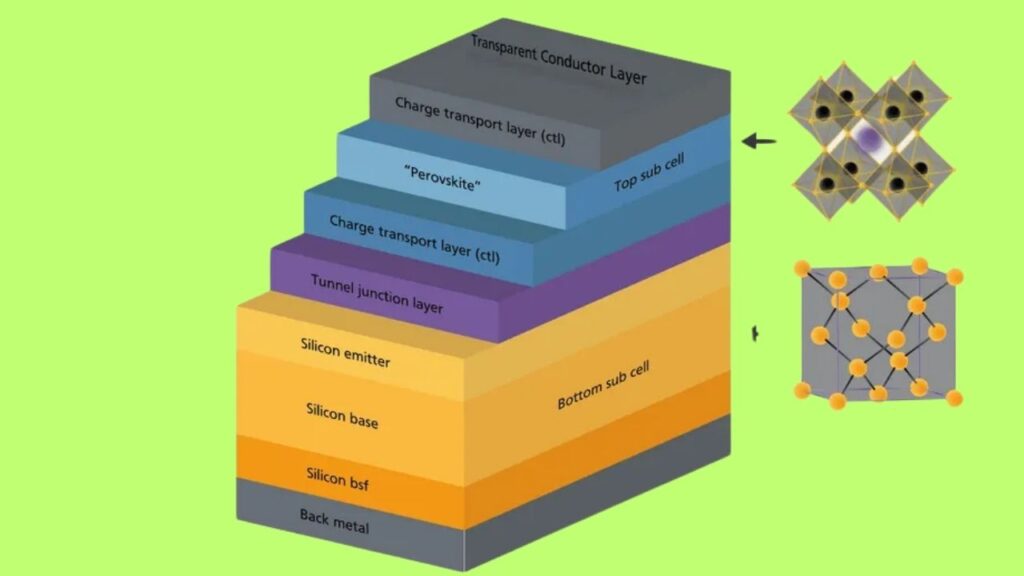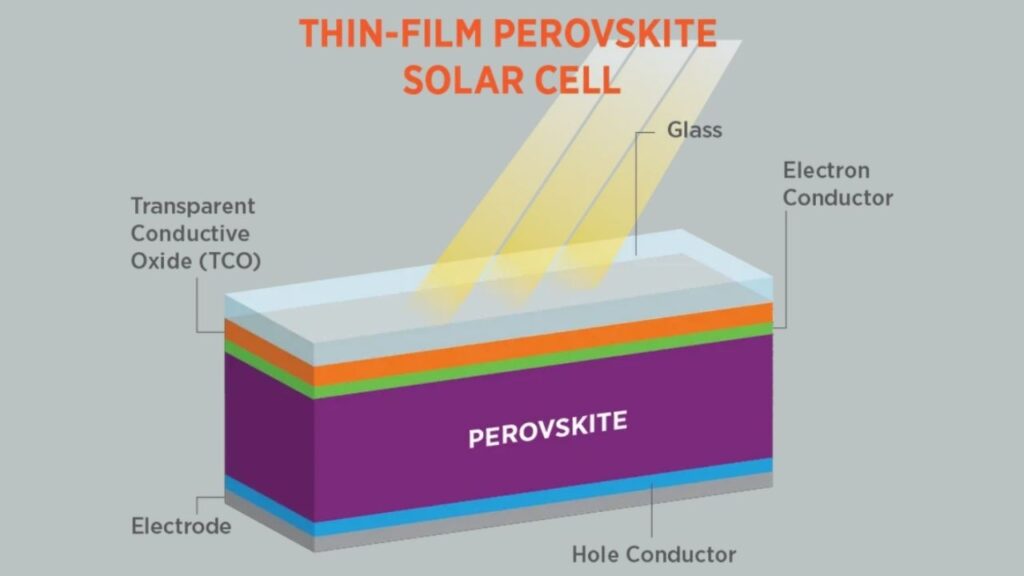Scientists Build 29.5 %‑Efficiency All‑Perovskite Tandem Solar Cells: Scientists are jazzed about this one: a team led by Huazhong University of Science and Technology in China just nailed a 29.5 percent certified efficiency in a two‑terminal, all‑perovskite tandem solar cell—and yep, that’s without any silicon mixed in. This breakthrough was independently certified by the Shanghai Institute of Microsystem and Information Technology (SIMIT).

Perovskite-based solar tech has zoomed from ~3.8 percent back in 2009 to over 25 percent in single-junction systems—not too shabby, right? Now, these latest all‑perovskite tandems are giving silicon-perovskite combos a real run for their money.
Scientists Build 29.5 %‑Efficiency All‑Perovskite Tandem Solar Cells
| What | Details |
|---|---|
| Record efficiency | 29.5 % certified in monolithic 2‑terminal all‑perovskite tandem |
| Stability | Maintains over 90 % efficiency after 430 h MPPT; 82 % after 150 h at 85 °C |
| Subcell performance | Narrow‐bandgap: 23.7 % PCE, Voc = 0.89 V Wide‐bandgap: 20.6 % PCE, Voc = 1.33 V |
| Module test | 5 × 5 cm mini‑module hits ~24.7 % efficiency |
| Crystal & Voc details | (100) orientation + two‑junction Voc ~2.18–2.21 V |
| Why it matters | Removes silicon—cheaper, lighter, flexible Tandem market projected to grow—enterprises eye $9B by 2034 |
| Credible source | Nature Communications study (June 2025) |
The 29.5 percent certified efficiency in a monolithic, all‑perovskite tandem solar cell is not just lab buzz—it’s a legit step toward a silicon-free, lightweight solar future. With savvy interface engineering, crystal orientation control, and small‑format module scaling, this technology’s path is clear: pilot plants, commercial pods, and flexible deployments—all lining up over the next few years.
We still need long-term stability proof, certification scaling, and industrial-grade encapsulation—but with resources shifting, tariffs fluctuating, and flexible solar on the rise, perovskites seem ready to drive the next solar wave.
What’s an “All‑Perovskite Tandem,” Anyway?

Tandem Basics Made Simple
A tandem solar cell stacks two layers:
- The top layer grabs high‑energy (blue/green) sunlight
- The bottom layer catches the lower-energy (red/infrared) stuff
Stack ’em together, and you cover more of the sunlight spectrum than a solo cell could. Silicon-perovskite tandems have topped ∼32 percent efficiency—but going all‑perovskite means ditching silicon. That simplifies things, slashes weight, and opens doors for flexible solar panels.

Why This Record’s a Big Deal
- Interface wizardry: Researchers engineered a buried layer with a mercapto‑functionalized mesoporous silica scaffold (MSN‑SH) that’s like Teflon for defects—cutting ion migration, killing recombination, boosting electron flow.
- Crystal finesse: They oriented the wide‑bandgap perovskite in the (100) plane to reduce voltage loss.
- Certified win: Voc ~2.18 V, Jsc ~16.25 mA/cm², Fill Factor ~83.3 percent, steady-state PCE ~28.7–29.5 percent.
Breaking It Down—How They Did It
Step 1 – Design the Chemistry
- Top cell: 1.77 eV wide‑bandgap lead‑based perovskite
- Bottom cell: Sn‑Pb narrow‑bandgap (~1.2 eV), sweet spot for infrared capture
Step 2 – Layer the Magic Scaffold
They applied a custom nanoparticle scaffold functionalized with mercapto groups to clean up the buried interface, reduce voids, and stabilize tin oxidation—bigger electron lifetimes, better retention.
Step 3 – Optimize Crystallization
Tweaked perovskite growth for dominant (100) orientation, which limits trap densities and enhances charge travel.
Step 4 – Stack It Right
Built a monolithic 2‑terminal architecture (wired straight through). Standard commercial architecture.
Step 5 – Test & Verify
Independent lab certified 29.50 percent under standard conditions (Voc 2.179 V, Jsc 16.25 mA/cm², FF 83.29 %).
Mini-module (5 × 5 cm²) clocked in at ~24.7 percent efficiency. Stability holds: over 90 percent after 430 h MPPT, 82 percent after 150 hr at 85 °C.
Why This Matters Right Now
Silicon-Free = Game Changer
Ditching silicon reduces manufacturing complexity and supply chain reliance. Result? Lighter panels with flexibility—think rollable or wearable solar skin.
Emerging Market Impact
Perovskite tandems expected to hit ~$9 B by 2034 (CAGR ~35%). As efficiencies improve, these become top picks for thin-film solar.
Competitive Cost Center
Even at $0.30–0.40 per watt, that efficiency brings the cost-per-watt into silicon’s territory (~$0.20/W baseline). If silicon costs spike due to tariffs or material limits, perovskite could surge ahead.
Approaching Physics Limits
Single-junction silicon maxes around 29–30 percent. All-perovskite tandems could inch toward 36 percent plus—right up there with industry giants.
Practical Guide for Solar Pros
R&D Leaders
- Read the original Nature paper for methods and data.
- Replicate the MSN‑SH interface across different lab settings.
- Improve encapsulation processes to treat stability.
Project Directors
- Keep tabs on silicon costs: if tariffs rise, this tech shines.
- Start pilot rooftop programs with perovskite modules—like vehicle wraps or building facades.
Investors & Policymakers
- Support subsidies for perovskite pilot plants.
- Back investments in encapsulation tech to pass safety and longevity tests.
Tech Trainers
- Train teams in blade-coating and slot-die deposition.
- Monitor real ambient data during 1‑sun exposure over months.
CO₂ to Methane Conversion Unlocked by Tweaking Nickel Nanoparticle Shape
Strange Memory Effect Found Controlling Quantum Atomic Motion on Metals
Bigger Molecules Now Proven to Extend Quantum Charge Flow Like Never Before
FAQs About Scientists Build 29.5 %‑Efficiency All‑Perovskite Tandem Solar Cells
Q: How long do these cells last?
A: Lab testing shows ~90 percent efficiency after 430 h MPPT and 82 percent after 150 h at 85 °C—promising, but long-term field data is still pending.
Q: Are they cost-effective now?
A: Module costs estimated at $0.30–0.40/W. With high efficiency, they rival silicon—especially where silicon faces trade barriers.
Q: When will we see them in stores?
A: Prototype modules are here. With stability and scale tests underway, expect commercial versions in ~3–5 years.
Q: How do they stack up to perovskite-silicon tandem cells?
A: Silicon-perovskite systems have reached 29.5–32.5 percent efficiency. All-perovskite tandems hit ~29.5 percent now but offer lower weight and simpler manufacture.
Q: What’s next?
A: Upscale to full-size modules, ensure UV/moisture resistance, and gather real-world aging data.






